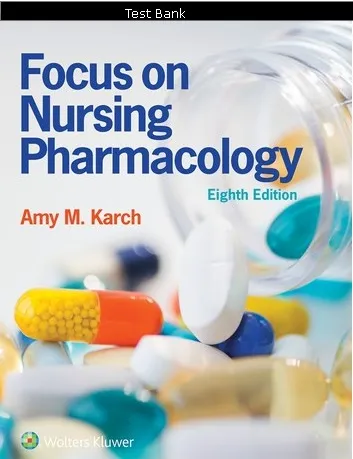Focus on Nursing Pharmacology 8th Edition Test Bank
$55.00 Original price was: $55.00.$18.00Current price is: $18.00.
Digital item No Waiting Time Instant Download
Format: PDF
Chapters: 59
ISBN-13: 978-1975100964
ISBN-10: 1975100964.
Publisher: LWW; 8th edition
Author: Amy M. Karch
Description
Focus on Nursing Pharmacology 8th Edition Test Bank
Table of Contents
Chapter 01 – Introduction to Drugs
Chapter 02 – Drugs and the Body
Chapter 03 – Toxic Effects of Drugs
Chapter 04 – The Nursing Process in Drug Therapy and Patient Safety
Chapter 05 – Dosage Calculations
Chapter 06 – Challenges to Effective Drug Therapy
Chapter 07 – Introduction to Cell Physiology
Chapter 08 – Antiinfective Agents
Chapter 09 – Antibiotics
Chapter 10 – Antiviral Agents
Chapter 11 – Antifungal Agents
Chapter 12 – Antiprotozoal Agents
Chapter 13 – Anthelmintic Agents
Chapter 14 – Antineoplastic Agents
Chapter 15 – Introduction to the Immune Response and Inflammation
Chapter 16 – Antiinflammatory, Antiarthritis, and Related Agents
Chapter 17 – Immune Modulators
Chapter 18 – Vaccines and Sera
Chapter 19 – Introduction to Nerves and the Nervous System
Chapter 20 – Anxiolytic and Hypnotic Agents
Chapter 21 – Antidepressant Agents
Chapter 22 – Psychotherapeutic Agents
Chapter 23 – Antiseizure Agents
Chapter 24 – Antiparkinsonism Agents
Chapter 25 – Muscle Relaxants
Chapter 26 – Narcotics, Narcotic Antagonists, and Antimigraine Agents
Chapter 27 – General and Local Anesthetic Agents
Chapter 28 – Neuromuscular Junction Blocking Agents
Chapter 29 – Introduction to the Autonomic Nervous System
Chapter 30 – Adrenergic Agonists
Chapter 31 – Adrenergic Antagonists
Chapter 32 – Cholinergic Agonists
Chapter 33 – Anticholinergic Agents
Chapter 34 – Introduction to the Endocrine System
Chapter 35 – Hypothalamic and Pituitary Agents
Chapter 36 – Adrenocortical Agents
Chapter 37 – Thyroid and Parathyroid Agents
Chapter 38 – Agents to Control Blood Glucose Levels
Chapter 39 – Introduction to the Reproductive System
Chapter 40 – Drugs Affecting the Female Reproductive System
Chapter 41 – Drugs Affecting the Male Reproductive System
Chapter 42 – Introduction to the Cardiovascular System
Chapter 43 – Drugs Affecting Blood Pressure
Chapter 44 – Agents for Treating Heart Failure
Chapter 45 – Antiarrhythmic Agents
Chapter 46 – Antianginal Agents
Chapter 47 – Lipid-Lowering Agents
Chapter 48 – Drugs Affecting Blood Coagulation
Chapter 49 – Drugs Used to Treat Anemias
Chapter 50 – Introduction to the Renal System
Test Bank – Focus on Nursing Pharmacology (8th Edition by Karch) 2
Chapter 51 – Diuretic Agents
Chapter 52 – Drugs Affecting the Urinary Tract and the Bladder
Chapter 53 – Introduction to the Respiratory System
Chapter 54 – Drugs Acting on the Upper Respiratory Tract
Chapter 55 – Drugs Acting on the Lower Respiratory Tract
Chapter 56 – Introduction to the Gastrointestinal System
Chapter 57 – Drugs Affecting Gastrointestinal Secretions
Chapter 58 – Drugs Affecting Gastrointestinal Motility
Chapter 59 – Antiemetic Agents
Test Bank – Focus on Nursing Pharmacology (8th Edition by Karch) 3
Chapter 01 – Introduction to Drugs
A nurse working in radiology administers iodine to a patient who is having a computed tomography (CT)
scan. The nurse working on the oncology unit administers chemotherapy to patients who have
cancer. At the Public Health Department, a nurse administers a measles-mumps-rubella (MMR)
vaccine to a 14-month-old child as a routine immunization. Which branch of pharmacology best
describes the actions of all three nurses?
Pharmacoeconomics
Pharmacotherapeutics
Pharmacodynamics
Pharmacokinetics
Ans: B
Feedback:
Pharmacology is the study of the biologic effects of chemicals. Nurses are involved with clinical
pharmacology or pharmacotherapeutics, which is a branch of pharmacology that deals with the uses of
drugs to treat, prevent, and diagnose disease. The radiology nurse is administering a drug to help
diagnose a disease. The oncology nurse is administering a drug to help treat a disease.
Pharmacoeconomics includes any costs involved in drug therapy. Pharmacodynamics involves how a
drug affects the body and pharmacokinetics is how the body acts on the body.
A physician has ordered intramuscular (IM) injections of morphine, a narcotic, every 4 hours as needed for
pain in a motor vehicle accident victim. The nurse is aware this drug has a high abuse potential.
Under what category would morphine be classified?
Schedule I
Schedule II
Schedule III
Schedule IV
Ans: B
Feedback:
Narcotics with a high abuse potential are classified as Schedule II drugs because of severe dependence





Be the first to review “Focus on Nursing Pharmacology 8th Edition Test Bank”